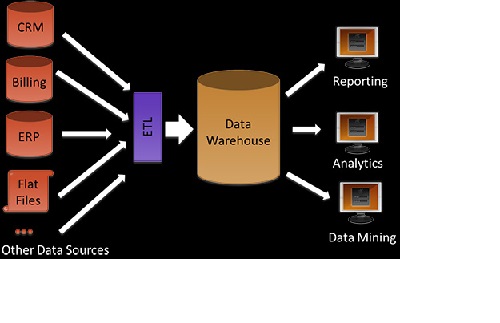What is Data Warehouse:
This determines capturing the data from various sources for analyzing and accessing but not generally the end users who really want to access them sometimes from local data base.Check its advantages, disadvantages and PDF tutorials.
Data warehouse with (DW) as short form is a collection of corporate information and data obtained from external data sources and operational systems which is used to guide corporate decisions. A data warehouse is structured to support business decisions by permitting you to consolidate, analyse and report data at different aggregate levels. Data is sent into the Data warehouse through the stages of extraction, transformation and loading.
Data warehousing is the act of extracting data from many dissimilar sources into one area transformed based on what the decision support system requires and later stored in the warehouse. For instance, a company stores information pertaining to its employees, developed products, employee salaries, customer sales and invoices, information. The CEO of an enterprise might want to ask a question concerning the most recent cost-reduction procedures; the answers will mean analyzing all of this data.
As a result, this is a major service of the data warehouse, which is allowing executives to make business decisions from all these very different crude data items.
It’s obvious that Data warehousing has the capability to influence future vital making of decisions. As illustrated in the above scenario, an enterprise executive can use warehouse data to find out the demand of a particular product by the market, data of sales based on geographical zone or answers any other kind of inquiries put forward. This gives insight about needed steps to more efficiently market a given product. Data warehouse has blocks of historical data unlike a working data store that could be analyzed to reach crucial business decisions. The efficiency of data warehousing makes many big corporations to use it despite its financial implication and effort.
Difference Between Data Warehouse and regular Database
The regular databases are specialized in maintaining uncompromising accuracy of data in the present by quickly updating data real-time. Meanwhile, Data warehouses are created to give a long-range perspective of data over time. They look off transaction size and specialize in data clustering.
There are two approaches to data warehousing:
One is Top Down approach, which spins down the data for specific users after the completion of data warehouse has been created. The second one is Bottom Up approach, that builds the data first, and them combines all of the data to one to an all encompassing data warehouse.
Data warehousing is basically collection of data that supports better management decision making for gaining better organizational goals and efficiency.

ADVANTAGES:
- Controls data which helps it to be clean and protected.
- Indexes of multiple types
- It involved multiple options of query processing.
- Provides full security of data and the ability to access them in a proper way.
DISADVANTAGES:
- When data users lose control over their data, then security and privacy issues will arise leading to leakage of their data.
- Adding new data takes lot of time and includes cost.
- No data drill down capabilities.
- Cannot actively monitor changes in a data.

